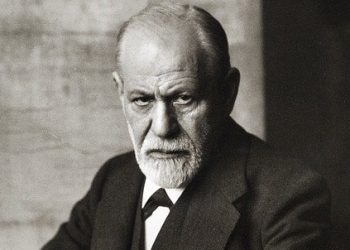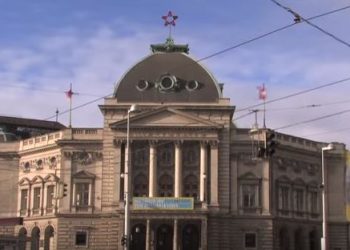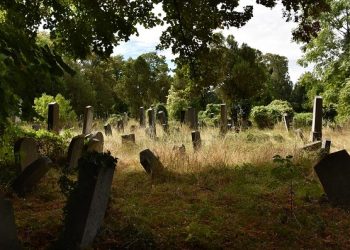In Vienna, one can find remnants and reminders of the magnificent Jewish life that existed before the horrors of the Holocaust. On many streets throughout the city, there are small, golden memorial plaques bearing the names of Jews who lived in the buildings on these streets. These Jews were deported and sent to extermination camps. The memorial plaques alone prove how full the city was of Jews and a thriving Jewish community. Fortunately, the Jewish community is flourishing again in Vienna in recent years, and Jewish life in the city has improved immensely. Read more about the history of the community and Jewish life in Vienna today.
Besides memorial plaques and major Jewish attractions like the Great Synagogue, the Jewish Museum, etc., there are several places with Jewish history that many visitors to the city are unaware of. In this article, we will detail 5 less-touristy Jewish places around Vienna.
1. The Statue of Sonnenfels – City Hall (Rathaus)
Vienna’s City Hall is a stunningly beautiful building and undoubtedly one of Vienna’s must-see sites. It’s worth visiting its square by day and by night when the building is spectacularly illuminated. Next to the City Hall, there is a beautiful park with statues and fountains. One of the statues in the park is of Joseph von Sonnenfels, who was Jewish, a jurist, a leader of the Illuminati movement in Austria, and a close friend of Mozart. During the Nazi regime, his statue was removed from the Rathaus square, but after the war, it was returned to its place.
Address: Friedrich-Schmidt-Platz 1, 1010 Wien
Map:
2. The Theodor Herzl Stairs (Herzl Gedenktafel)
From a distance, this staircase may seem insignificant, and it doesn’t look particularly special or beautiful. As you get closer, you can see a plaque nearby explaining its historical importance. The stairs are named the Herzl Stairs because they were near the house where Theodor Herzl lived. The plaque next to the stairs has a dedication to Herzl for his work and his bold vision for the establishment of the Jewish state. The stairs lead to Desider-Friedmann-Hof, named after a leader of the Zionist movement in Vienna who was sent to the Auschwitz extermination camp in 1944.
The stairs are located between Judengasse and Marc-Aurel-Straße.
Address: Sterngasse 3, 1010 Wien, Austria
Map:
3. Looshaus – The Loos House in St. Michael’s Square
Every corner of Vienna holds places with Jewish history. Even in St. Michael’s Square, near the Hofburg Palace, there is a beautifully designed building that exemplifies the wealth of Viennese Jews. This building is called the Looshaus, after the architect Adolf Loos who designed it. This building is considered one of the most central examples of the Viennese Modern style. It was built at the beginning of the 20th century for the Jewish businessman Leopold Goldman. The luxury men’s fashion store Goldman & Salatsch operated there. In 1944, due to its proximity to the Hofburg Palace, the building was damaged by Allied bombing but was renovated in the following years. Today, it is on Vienna’s list of protected buildings and is owned by one of Vienna’s largest banks, Raiffeisenbank. If you’re passing through the square, it’s worth stopping by and peeking inside. Its interior design is still antique and particularly impressive.
How to get to the Looshaus?
The nearest subway station to this building is Herrengasse station. The orange line – U3 – passes through this station. From there, it’s about a 2-minute walk.
Address: Michaelerplatz 3, 1010 Wien
Map:
4. The Oldest Jewish Cemetery in Vienna
The Jewish cemetery located on Seegasse in the 9th district is the oldest in the city, opened as early as 1540. It is certainly a special and historic place that was neglected for a long time and largely destroyed by the Nazis. In recent years, conservation and restoration work has been carried out in the cemetery to save the ancient tombstones and return those that were taken. The tombstones in the cemetery are from the 16th, 17th, and 18th centuries. Important people from the Jewish community, such as Rabbi Menachem Hendel, Rabbi Simeon Auerbach, the banker Samuel Oppenheimer, and others are buried here.
Today, the cemetery is located next to the Rossau nursing home, and you can enter it during the day through the nursing home’s entrance. The opening hours are: Monday – Friday from 8:00 AM to 3:00 PM.
Address: Seegasse 9-11, 1090 Wien
Map:
5. The Ottakringer Brewery (Brauerei Ottakringer)
This is the largest brewery in Vienna and one of the largest among Austrian breweries. The brewery was founded in 1837 by Heinrich Plank in the city’s suburbs. From 1850 until the Holocaust, it was under Jewish ownership after the founder fell into financial debt and had to sell the brewery. The new owners were cousins Jacob and Ignaz Kuffner from Moravia, who decided to turn the brewery into a regional empire. They improved working conditions, accelerated the production process, and became a beer powerhouse that formed the basis for the success of Ottakringer beer. During the Holocaust, the Nazis confiscated it, and it has remained in Austrian hands to this day.
For many years, the new owners of the brewery refused to acknowledge its Jewish history, and only in recent years has a memorial plaque been installed in memory of the Jewish owners.
Address: Ottakringer Pl. 1, 1160 Wien
Map:
Read more information about the Jewish community in Vienna and other Jewish places around the city.


















